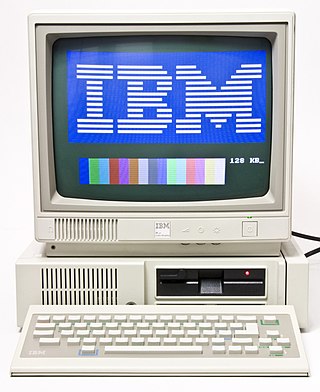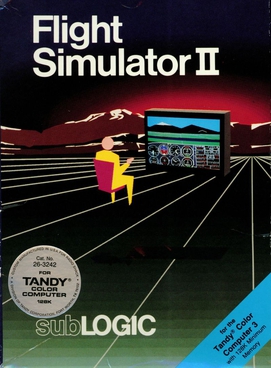
The IBM Personal Computer is the first microcomputer released in the IBM PC model line and the basis for the IBM PC compatible de facto standard. Released on August 12, 1981, it was created by a team of engineers and designers directed by Don Estridge in Boca Raton, Florida.

VisiCalc is the first spreadsheet computer program for personal computers, originally released for Apple II by VisiCorp on October 17, 1979. It is considered the killer application for the Apple II, turning the microcomputer from a hobby for computer enthusiasts into a serious business tool, and then prompting IBM to introduce the IBM PC two years later. More than 700,000 copies were sold in six years, and up to 1 million copies over its history.

Zork is a text-based adventure game first released in 1977 by developers Tim Anderson, Marc Blank, Bruce Daniels, and Dave Lebling for the PDP-10 mainframe computer. The original developers and others, as the company Infocom, expanded and split the game into three titles—Zork I: The Great Underground Empire, Zork II: The Wizard of Frobozz, and Zork III: The Dungeon Master—which were released commercially for a range of personal computers beginning in 1980. In Zork, the player explores the abandoned Great Underground Empire in search of treasure. The player moves between the game's hundreds of locations and interacts with objects by typing commands in natural language that the game interprets. The program acts as a narrator, describing the player's location and the results of the player's commands. It has been described as the most famous piece of interactive fiction.

IBM PC compatible computers are similar to the original IBM PC, XT, and AT, all from computer giant IBM, that are able to use the same software and expansion cards. Such computers were referred to as PC clones, IBM clones or IBM PC clones. The term "IBM PC compatible" is now a historical description only, since IBM no longer sells personal computers after it sold its personal computer division in 2005 to Chinese technology company Lenovo. The designation "PC", as used in much of personal computer history, has not meant "personal computer" generally, but rather an x86 computer capable of running the same software that a contemporary IBM PC could. The term was initially in contrast to the variety of home computer systems available in the early 1980s, such as the Apple II, TRS-80, and Commodore 64. Later, the term was primarily used in contrast to Apple's Macintosh computers.
A killer application is any software that is so necessary or desirable that it proves the core value of some larger technology, such as its host computer hardware, video game console, software platform, or operating system. Consumers would buy the host platform just to access that application, possibly substantially increasing sales of its host platform.

The IBM PCjr was a home computer produced and marketed by IBM from March 1984 to May 1985, intended as a lower-cost variant of the IBM PC with hardware capabilities better suited for video games, in order to compete more directly with other home computers such as the Apple II and Commodore 64.

Softdisk was a software and Internet company based in Shreveport, Louisiana. Founded in 1981, its original products were disk magazines. It was affiliated and partly owned by paper magazine Softalk at founding, but survived its demise.

Softporn Adventure is a comedic, adult-oriented text adventure game produced for the Apple II in 1981. The game was created by Charles Benton and released by On-Line Systems, later renamed Sierra On-Line. Years later, Softporn Adventure was remade and expanded as Leisure Suit Larry series of adult-oriented video games, and the first entry in that series, 1987's Leisure Suit Larry in the Land of the Lounge Lizards, was a nearly direct graphical adaptation of Softporn Adventure. Another graphical version was released as Las Vegas for various Japanese computers in 1986 by Starcraft.
Edu-Ware Services, Inc. was an educational and entertainment software publisher established in 1979 by Sherwin Steffin and Steven Pederson. It was known for its adventure games, role-playing video games, and flight simulators for the Apple II series of computers.

Apple Inc, originally named Apple Computer, Inc., is a multinational corporation that creates and markets consumer electronics and attendant computer software, and is a digital distributor of media content. Apple's core product lines are the iPhone smartphone, iPad tablet computer, and the Macintosh personal computer. The company offers its products online and has a chain of retail stores known as Apple Stores. Founders Steve Jobs, Steve Wozniak, and Ronald Wayne created Apple Computer Co. on April 1, 1976, to market Wozniak's Apple I desktop computer, and Jobs and Wozniak incorporated the company on January 3, 1977 , in Cupertino, California.
Penguin Software was a computer software and video game publisher from Geneva, Illinois that produced graphics and application software and games for the Apple II, Macintosh, IBM, Commodore 64, Amiga, Atari 8-bit, and Atari ST computers. They produced the graphics programs Graphics Magician and Complete Graphics System, graphic adventure games such as the Transylvania series, arcade-style games like Spy's Demise, and role-playing video games such as Xyphus.
Nasir Gebelli is an Iranian-American programmer and video game designer usually credited in his games as simply Nasir. Gebelli wrote Apple II games for Sirius Software, created his own company Gebelli Software, and worked for Squaresoft. He became known in the early 1980s for producing fast action games for the Apple II, including 3D shooters.

Super Invader is a fixed shooter video game written by Japanese programmer M. Hata for the Apple II and published by Creative Computing Software in November 1979. Super Invader is a clone of Space Invaders.

Following the introduction of the IBM Personal Computer, or IBM PC, many other personal computer architectures became extinct within just a few years. It led to a wave of IBM PC compatible systems being released.

The history of the personal computer as a mass-market consumer electronic device began with the microcomputer revolution of the 1970s. A personal computer is one intended for interactive individual use, as opposed to a mainframe computer where the end user's requests are filtered through operating staff, or a time-sharing system in which one large processor is shared by many individuals. After the development of the microprocessor, individual personal computers were low enough in cost that they eventually became affordable consumer goods. Early personal computers – generally called microcomputers – were sold often in electronic kit form and in limited numbers, and were of interest mostly to hobbyists and technicians.
Stickybear is a fictional character created by Richard Hefter and an edutainment series starring the character headed by Optimum Resource, Inc. The character was a mascot of Weekly Reader Software, a division of Xerox Education Publications.

Sleuth is a text-based "whodunit" video game created by Eric N. Miller of Norland Software. It was first released in 1983.
Softape was an Apple II software company that published computer games, utilities and productivity programs for the Apple II series of personal computers in the late 1970s and early 1980s. It was co-founded by William V. R. Smith, Bill Depew and Gary Koffler. In 1980, the company's name was changed to Artsci, Inc. (artscipub.com) and they now operate as an internet service provider as well as publish literature on amateur radio.

Flight Simulator II is a video game developed by Bruce Artwick and published by Sublogic as the sequel to FS1 Flight Simulator. It was released in December 1983 for the Apple II, in 1984 for Atari 8-bit and Commodore 64, in 1986 for the Amiga and Atari ST, the Atari XEGS as a pack-in title in 1987 and in August 1988 for the Color Computer 3.
Margot Comstock was co-founder and editor of Softalk magazine, which was influential in the Apple II community, as part of a growing personal computing movement.













